
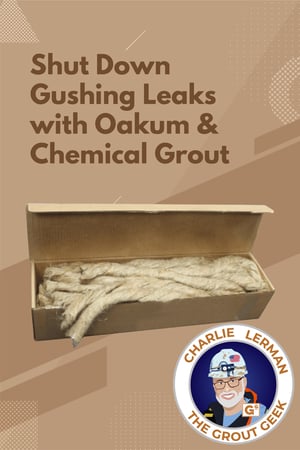 Polyurethane chemical grout injection can be a bit of a Pandora’s box at times. So, what can be done to help combat some of these uncertainties? Well, how about the easiest and most cost-effective solution first. Oakum! Not only is it amazing what you can accomplish with it, but it is vital to have on every job. YES, I SAID EVERY JOB.
Polyurethane chemical grout injection can be a bit of a Pandora’s box at times. So, what can be done to help combat some of these uncertainties? Well, how about the easiest and most cost-effective solution first. Oakum! Not only is it amazing what you can accomplish with it, but it is vital to have on every job. YES, I SAID EVERY JOB.
There are only two things that have to happen for successful water mitigation. One, get the grout to the right location. Two, keep it there long enough to react. With tight cracks, it can be difficult to get the grout to travel in the crack, but once you get it there it is good to go. With wide cracks or high flow leaks, getting to the right place is easy, but keeping it there long enough to set up can be challenging.
You can use oakum to control grout and keep it where you want it in the crack or joint. Remember we are doing the injection work to stop the flow of water, so let’s make the least amount of holes possible in the concrete. But what does that have to do with oakum? Cracks are irregular, and often have sections that are wider in some sections. When this wider area is at the surface it can allow an easy escape path for a grout under pressure. That means you are wasting grout and not getting it where it needs to be, deep in the crack. Sure, if you have raw resin coming out of the crack you can just wait for it to cure. Once cured you cannot reinject that packer, so it is best to surface seal that crack and stop or slow down the loss of grout. This allows you to continue effective pumping into the crack or joint.
If the crack or joint is wide, grout impregnated oakum can be packed in place. While messy, this is the equivalent of finger painting with chemical grouts and is an easy process.
If you're thinking "I have rags, I don’t need oakum", think again. Oakum is stronger, can be pulled apart into just a few fibers if needed, and can be stuffed into very tiny defects where rags cannot fit.
Want more information on leak seal products?


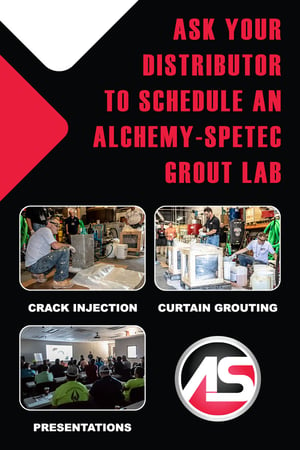 Alchemy-Spetec grout labs are a great way to learn about industry-leading polyurethane leak seal products and applications. These are usually half-day events featuring...
Alchemy-Spetec grout labs are a great way to learn about industry-leading polyurethane leak seal products and applications. These are usually half-day events featuring...


 One of the many joys of my job is going to all corners of North America and participating in unique projects. While I am a seasoned traveler, cement is not. Cement grout often requires heavy equipment. Shipping cement grout and related equipment can be expensive. While often not a concern for most projects, it is a driving factor for remote locations.
One of the many joys of my job is going to all corners of North America and participating in unique projects. While I am a seasoned traveler, cement is not. Cement grout often requires heavy equipment. Shipping cement grout and related equipment can be expensive. While often not a concern for most projects, it is a driving factor for remote locations.

 Polyurethane chemical grout injection can be a bit of a Pandora’s box at times. So, what can be done to help combat some of these uncertainties? Well, how about the easiest and most cost-effective solution first. Oakum! Not only is it amazing what you can accomplish with it, but it is vital to have on every job. YES, I SAID EVERY JOB.
Polyurethane chemical grout injection can be a bit of a Pandora’s box at times. So, what can be done to help combat some of these uncertainties? Well, how about the easiest and most cost-effective solution first. Oakum! Not only is it amazing what you can accomplish with it, but it is vital to have on every job. YES, I SAID EVERY JOB.
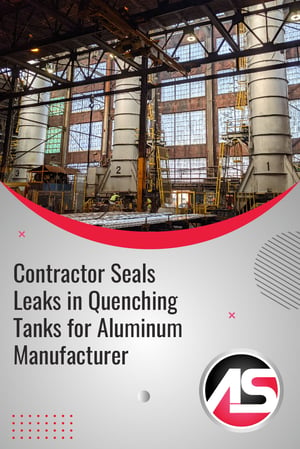 A large Mid-Western aluminum manufacturer was losing water from all of its quenching tanks. Losing 3 million gallons in half a year can be expensive, not to mention the massive effect that volume of water can have on soil and the structures it supports. So, they reached out to one of their trusted maintenance contractors, who in turn came to Alchemy-Spetec for guidance on how to efficiently mitigate the leaks with minimal downtime.
A large Mid-Western aluminum manufacturer was losing water from all of its quenching tanks. Losing 3 million gallons in half a year can be expensive, not to mention the massive effect that volume of water can have on soil and the structures it supports. So, they reached out to one of their trusted maintenance contractors, who in turn came to Alchemy-Spetec for guidance on how to efficiently mitigate the leaks with minimal downtime. 
 Like with most issues, there is no one final answer, but let’s weigh the pros and cons. An easy one is cost: two-component urethanes are significantly more cost-effective than a single component IF you already have a rig to properly handle them. Keep in mind, not many leak seal contractors typically have a rig.
Like with most issues, there is no one final answer, but let’s weigh the pros and cons. An easy one is cost: two-component urethanes are significantly more cost-effective than a single component IF you already have a rig to properly handle them. Keep in mind, not many leak seal contractors typically have a rig.
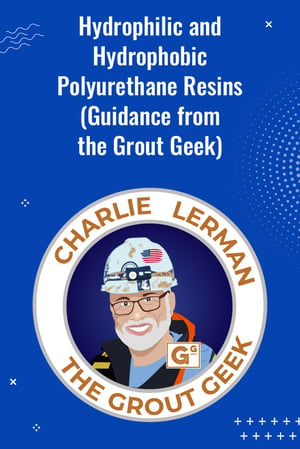 Newcomers to urethane grouts often cut their teeth on these two terms, but the industry in general struggles with the understanding of what they are, and when to use hydrophobic vs. hydrophilic polyurethane grouts. So, I will cover the differences and then point out what I feel is a much more important conversation about polyurethane chemical grouts.
Newcomers to urethane grouts often cut their teeth on these two terms, but the industry in general struggles with the understanding of what they are, and when to use hydrophobic vs. hydrophilic polyurethane grouts. So, I will cover the differences and then point out what I feel is a much more important conversation about polyurethane chemical grouts.
 Municipalities across North America have widespread problems with Inflow and infiltration (I&I). Inflow is in reference to stormwater that invades sewer systems. Infiltration is in reference to groundwater infiltrating manholes, lift stations, pipes, and other sanitary system components. While there are a few solutions on the market for mitigating inflow, this article is primarily focused on mitigating infiltration with polyurethane grout.
Municipalities across North America have widespread problems with Inflow and infiltration (I&I). Inflow is in reference to stormwater that invades sewer systems. Infiltration is in reference to groundwater infiltrating manholes, lift stations, pipes, and other sanitary system components. While there are a few solutions on the market for mitigating inflow, this article is primarily focused on mitigating infiltration with polyurethane grout.
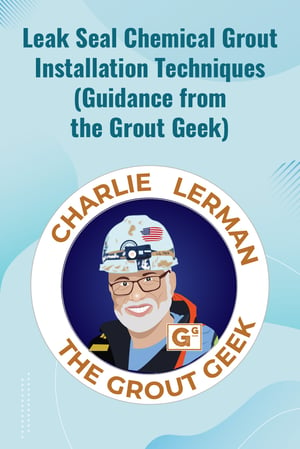 One of the most common questions I get about leak seal grout is along the lines of "Can I do this or that? Will it work?". I get this type of question regularly because every job is very unique and there is no one precise grouting procedure that fits everything. Let me introduce you to a term I love to use: exploratory grouting. This is the phase in which you are trying various methods until you find one that works for your particular application. While this just sounds like guesswork, it is very far from that.
One of the most common questions I get about leak seal grout is along the lines of "Can I do this or that? Will it work?". I get this type of question regularly because every job is very unique and there is no one precise grouting procedure that fits everything. Let me introduce you to a term I love to use: exploratory grouting. This is the phase in which you are trying various methods until you find one that works for your particular application. While this just sounds like guesswork, it is very far from that.
 Do you know that leak that returns every year no matter how much hydraulic cement you put on it? Why not make this next time the last time you have to mess with it? Polyurethane grouts have some unique properties that allow them to do things concrete cannot. One of the most glaring is its flexibility.
Do you know that leak that returns every year no matter how much hydraulic cement you put on it? Why not make this next time the last time you have to mess with it? Polyurethane grouts have some unique properties that allow them to do things concrete cannot. One of the most glaring is its flexibility.
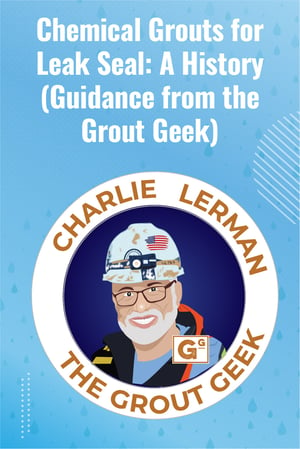 Polyurethane foam was first discovered in 1937 by Dr. Otto Bayer who lived in Leverkusen, Germany. Bayer was a German chemist and was the head of the research group that discovered this new material. His fundamental idea of combining small volumes of chemical substances together to react into a dry foam material was viewed to be an impossibility. But after many trials and difficulties, Bayer eventually succeeded in synthesizing the first polyurethane foam.
Polyurethane foam was first discovered in 1937 by Dr. Otto Bayer who lived in Leverkusen, Germany. Bayer was a German chemist and was the head of the research group that discovered this new material. His fundamental idea of combining small volumes of chemical substances together to react into a dry foam material was viewed to be an impossibility. But after many trials and difficulties, Bayer eventually succeeded in synthesizing the first polyurethane foam.